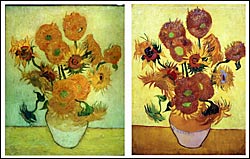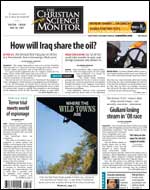from the May 10, 2007 edition
 |
|
Is that painting real? Ask a mathematician.
Engineers use a mathematical process dubbed 'stylometry' to set apart real Van Gogh paintings from forgeries.
By Elizabeth Svoboda | Contributor to The Christian Science MonitorPage 1 of 2
After Japanese insurance kingpin Yasuo Goto won a high-stakes bidding war by offering $39.9 million for a painting at a 1987 auction, an unforeseen controversy erupted: Was the painting, Vincent van Gogh's "Still Life: Vase With Fifteen Sunflowers," truly the work of the Dutch master, or a clever fake?
Some art dealers and historians thought the character of the brushstrokes differed from other Van Goghs; others disagreed. The stalemate was never resolved. But after 20 years, help is finally arriving from an unlikely quarter. Computer scientist Richard Johnson of Cornell University in Ithaca, N.Y., is embarking on an international project to define Van Gogh's unique style in mathematical terms, with the intent of shining a focused beam of objectivity on the traditionally muddled question of attribution.
On May 14, teams of engineers that Mr. Johnson recruited will meet with art students and curators at the Van Gogh Museum in Amsterdam to announce what they think sets real Van Gogh paintings apart from forgeries. By analyzing a database of 101 paintings by the artist and his known imitators, the scientists have arrived at what they say are key elements of Van Gogh's "visual signature," which can be distilled into numbers. This, they say, will give art experts an important new tool to assess works like "Vase With Fifteen Sunflowers." They can compare how closely a disputed painting's visual signature matches the baseline "signature" derived from the database.
"We want to get a dialogue going between computer scientists and art historians," Johnson says. "There's a lot of potential in this kind of cross-pollination."
The approach Johnson's teams are using, dubbed "stylometry," isn't limited to visual art. Scientists are also using statistical formulas to determine the authorship of letters, literary texts, and even musical compositions.
"There are techniques that allow you to turn an artwork into a point in some geometric space and ask, 'Is there a neighborhood of work of a particular artist?' " says Daniel Rockmore, a computer scientist at Dartmouth College who has published several papers on the topic.






